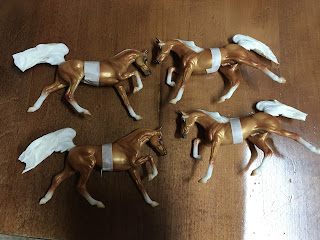With hobbyists painting models this February, I noticed several discussions about possible yellowing of primer, paint, and sealers. As artists we want our models to be enjoyed for many years to come. And, hopefully, their coat colors will remain true.I have been customizing since the late 1980s using a wide range of art supplies with a wide range of results. Although I do not have access to all of my work, I haven't seen any yellowing of the primer, acrylic paint, or sealer. Yet, I was curious about the discussions on Facebook. Was this an issue? Was it an issue with supplies that I used? Being married to a color scientist who works at a paint manufacturing company, my first thought was to run an... ex·per·i·mentnoun | ikˈsperəmənt, ekˈsperəmənt | a scientific procedure undertaken to make a discovery, test a hypothesis, or demonstrate a known fact
 |
| My subjects |
Step 1: Prime four Breyers with my usual primer Rust-Oleum 2X Ultra Cover in Flat White, leaving some factory paint and non-factory paint (white areas)
Step 2: Paint half of the four primed Breyers with my usual choice of JoSonia titanium white acrylic paint thinned with JoSonia flow medium and water using an airbrush. Apply 2 coats.
Step 3: Spray two with Testors Dull Cote and two with Krylon Matte.
Step 4:Remove tape from factory paint areas and label models with Sharpie.Place one Dull Cote and one Krylon on the widowsill of my porch. Place the others inside a sealed cardboard box also on the windowsill.
Step 5: Wait. The extreme temperatures (95+ degrees in the summer, 20 degrees in winter) and humidity (often 100%) of the porch will stress the primer, paint, and sealer. The two on the windowsill will be exposed to direct sunlight, the others will not. Step 6: Observe. In the coming months (or even years) will there be yellowing? I don't know. But I will post an update.___________ September 7, 2023 Update: It's been a hot, humid, and sunny summer. The models have not changed. __________Please note: Hobby artists all have their favorite art supplies and love to share what works for their models. While these supplies are not on everyone's favorite list, they are often available in my area. I find that they fit my work well, although they don't always agree with the weather forecast here in Michigan. The Rust-Oleum 2X Ultra Cover Flat White Primer and the Krylon were purchased in 2023. The Testors Dull Cote was purchased in about 2020. The Breyer models were from the Pintos and Palominos set and were purchased in 2023. They were not sanded in any way, nor was the factory finish altered.







Comments
Post a Comment